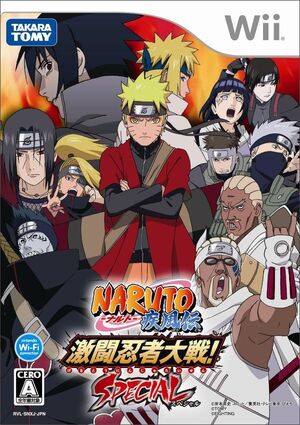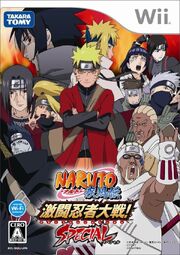m (→Gameplay) Tag: Visual edit |
m (→Gameplay) Tag: Visual edit |
||
| Line 16: | Line 16: | ||
Several changes have been made to the roster in that changes from ''[[Naruto Shippūden: Clash of Ninja Revolution 3]]'' have been carried over to this game, such as the new alternate special attacks, reworked Latent Ninja Powers, and the new alternate throws; however some characters such as the [[Sannin]] receive new default special attacks. Characters such as [[Anko]] (not seen since ''[[Naruto: Gekitō Ninja Taisen! 4|Gekitō Ninja Taisen! 4]]''), post-time skip [[Ino]], and [[Kakashi Hatake|Anbu Kakashi]] make their debut in [[Wikipedia:Japan|Japan]] from ''[[Naruto Shippūden: Clash of Ninja Revolution 3|Revolution 3]]'' (barring [[Towa]], [[Komachi]], [[Bando]] and [[Kagura (game)|Kagura]] however) as well as most of the ''[[Naruto: Clash of Ninja Revolution|Revolution]]'' series stages. Several new and altered characters also appear. Like with ''Revolution 3'', the game is [[Wikipedia:Wi-fi|Wi-fi]] compatible. |
Several changes have been made to the roster in that changes from ''[[Naruto Shippūden: Clash of Ninja Revolution 3]]'' have been carried over to this game, such as the new alternate special attacks, reworked Latent Ninja Powers, and the new alternate throws; however some characters such as the [[Sannin]] receive new default special attacks. Characters such as [[Anko]] (not seen since ''[[Naruto: Gekitō Ninja Taisen! 4|Gekitō Ninja Taisen! 4]]''), post-time skip [[Ino]], and [[Kakashi Hatake|Anbu Kakashi]] make their debut in [[Wikipedia:Japan|Japan]] from ''[[Naruto Shippūden: Clash of Ninja Revolution 3|Revolution 3]]'' (barring [[Towa]], [[Komachi]], [[Bando]] and [[Kagura (game)|Kagura]] however) as well as most of the ''[[Naruto: Clash of Ninja Revolution|Revolution]]'' series stages. Several new and altered characters also appear. Like with ''Revolution 3'', the game is [[Wikipedia:Wi-fi|Wi-fi]] compatible. |
||
| − | Also, a brand new [[Body Replacement Technique|substitution]] bar is added next to all characters' health bars and fill up from taking damage, which now allows the usage of the [[Body Replacement Technique]] without draining the main chakra bar. This also acts as the partner's own chakra bar in 2-Man Squad Tag Team battles for assist attacks. Another major feature is the ability to use both the Classic and Gamecube controller schemes to follow the motions to power-up specials, just like with the Wiimote + Nunchuck combo scheme. However, the guard gauge added in since ''[[Naruto: Gekitō Ninja Taisen! 4|Gekitō Ninja Taisen! 4]]'' has been removed from the HUD despite having the same function as well. |
+ | Also, a brand new [[Body Replacement Technique|substitution]] bar is added next to all characters' health bars and fill up from taking damage, which now allows the usage of the [[Body Replacement Technique]] without draining the main chakra bar. This also acts as the partner's own chakra bar in 2-Man Squad Tag Team battles for assist attacks. Another major feature is the ability to use both the Classic and Gamecube controller schemes to follow the motions to power-up specials, just like with the Wiimote + Nunchuck combo scheme. However, the guard gauge added in since ''[[Naruto: Gekitō Ninja Taisen! 4|Gekitō Ninja Taisen! 4]]'' has been removed from the HUD despite having the same function as well; the HP bar's indicator for reaching the Latent Ninja Power state is also removed. |
A good number of attacks also gain a wall-slamming effect, which allows the attacker to land a followup hit onto the victim which will put the said victim into a standing state when done at the correct timing before they crumple to the ground. As a result, stage transitions have been completely removed. |
A good number of attacks also gain a wall-slamming effect, which allows the attacker to land a followup hit onto the victim which will put the said victim into a standing state when done at the correct timing before they crumple to the ground. As a result, stage transitions have been completely removed. |
||
Revision as of 02:29, 21 May 2020
| Naruto Shippūden: Gekitō Ninja Taisen! Special | |||
|---|---|---|---|
 | |||
| (ナルト- 疾風伝 激闘忍者大戦! Special)
| |||
| Video game info | |||
| Playable on | Wii | ||
| Series | Naruto: Clash of Ninja | ||
| Previous | Naruto Shippūden: Gekitō Ninja Taisen! EX 3 | ||
| Release Date | |||
| Japanese | December 2, 2010 | ||
| Debut | |||
| |||
| |||
Naruto Shippūden: Gekitō Ninja Taisen! Special (-ナルト- 疾風伝 激闘忍者大戦! Special) is the eighth instalment of the Gekitō Ninja Taisen series, as well as Takara TOMY's final licensed Naruto game.
Gameplay
Several changes have been made to the roster in that changes from Naruto Shippūden: Clash of Ninja Revolution 3 have been carried over to this game, such as the new alternate special attacks, reworked Latent Ninja Powers, and the new alternate throws; however some characters such as the Sannin receive new default special attacks. Characters such as Anko (not seen since Gekitō Ninja Taisen! 4), post-time skip Ino, and Anbu Kakashi make their debut in Japan from Revolution 3 (barring Towa, Komachi, Bando and Kagura however) as well as most of the Revolution series stages. Several new and altered characters also appear. Like with Revolution 3, the game is Wi-fi compatible.
Also, a brand new substitution bar is added next to all characters' health bars and fill up from taking damage, which now allows the usage of the Body Replacement Technique without draining the main chakra bar. This also acts as the partner's own chakra bar in 2-Man Squad Tag Team battles for assist attacks. Another major feature is the ability to use both the Classic and Gamecube controller schemes to follow the motions to power-up specials, just like with the Wiimote + Nunchuck combo scheme. However, the guard gauge added in since Gekitō Ninja Taisen! 4 has been removed from the HUD despite having the same function as well; the HP bar's indicator for reaching the Latent Ninja Power state is also removed.
A good number of attacks also gain a wall-slamming effect, which allows the attacker to land a followup hit onto the victim which will put the said victim into a standing state when done at the correct timing before they crumple to the ground. As a result, stage transitions have been completely removed.
Due to the involvement of the prior director for the GameCube titles, the juggle combo physics are now closer to the GameCube games as opposed to the Wii games (characters now fall less faster during juggles). Another new major change is a number of characters now having moves that can be performed only when their own back is turned against their opponent.
Playable Characters
- Naruto Uzumaki (can enter a Three-Tailed form, also playable in a Sage Mode form)
- Sasuke Uchiha
- Sakura Haruno
- Kakashi Hatake (also playable with an Anbu outfit)
- Yamato
- Sai
- Might Guy
- Rock Lee
- Neji Hyūga
- Tenten
- Asuma Sarutobi
- Shikamaru Nara
- Ino Yamanaka
- Chōji Akimichi
- Kurenai Yūhi
- Kiba Inuzuka
- Shino Aburame
- Hinata Hyūga (also playable in an Awakened form)
- Chiyo
- Gaara
- Kankurō
- Temari
- Baki
- Itachi Uchiha
- Kisame Hoshigaki
- Deidara
- Sasori (also playable while in Hiruko)
- Hidan
- Kakuzu
- Jiraiya
- Tsunade
- Orochimaru
- Kabuto Yakushi
- Anko Mitarashi
- Yūgao Uzuki
- A
- Killer B (can enter a Four-Tailed form)
- Minato Namikaze
Stages
- Hidden Leaf Village
- Hidden Leaf Village Main Gate
- Akatsuki Hideout
- Tenchi Bridge
- Chūnin Exams
- Leaf Forest (Day, Night)
- Tanzaku Castle
- Nine-Tailed Fox Room
- Final Valley
- Hidden Leaf Village Riverside
- Hidden Leaf Village Pillar Chamber
- Forest Hideout
- Warehouse Road
- Shirato Street
- Intersection
- Hidden Sand Village
- Third Training Field
- Silent Shrine
Trivia
- A majority of the soundtrack is switched around from stage to stage and such:
- A number of story mode soundtracks being reused across games for other scenarios, such as one of the new story mode BGMs from Revolution 2 being used for the main menu, while the character select screen now one of the story mode themes added in since Gekitō Ninja Taisen! 3.
- The Shirato Street theme being replaced with the Hokage's Monument theme throughout the EX games, while the returning original monument/mansion theme returns in its place.
- Orichimaru's Lair theme being replaced with one of the story mode tracks from Revolution 2.
- The default Valley of the End's theme being the 3 Way Deadlock theme. Like in Revolution 3 however, having Naruto (normal version only) against Sasuke on this stage plays the original Gekitō Ninja Taisen! 4 leitmotif for the stage.
- The Tenchi Bridge's theme being replaced with the theme for Root's hideout.
- This is also the only Gekitō Ninja Taisen game to have no specific musical track for the versus screen.
- Ino in this game reuses some assets of Part I Sakura, such as the base of her moveset and her original shoving throw (along with borrowing more from her new additions since Clash of Ninja: Revolution 2 due to Asuma and Chōji being playable which would conflict with her prior usage of the Mind Body Switch Technique).
- In Hinata's Mission Mode, when facing Ino in one battle, the pre-battle dialogue between them has Ino comically lampshade the fact (via breaking the fourth wall) that "she hasn't even appeared in Gekitō EX once".
- Sage Mode Naruto, unlike normal Naruto since the first EX game, does not have his mouth rendered as wide.
- Likewise, Part 2 Sasuke in this game now has an outline on his hair (whereas his previous version did not).
- Sage Mode Naruto also differs from normal Naruto in a variety of ways:
- He is unable to fill up his own chakra gauge normally, as he must use his back special in order to summon a meditating clone to refill his chakra reserves without being interrupted. The addition of the universal Body Replacement bar for all characters is likely to accommodate for this gimmick.
- As long as he has any amount of chakra, he is able to have some of his punching attacks be imbued with an automatic Rasengan, akin to his father Minato. However, this uses up a small amount of chakra (around 5%) much like Deidara's moveset.
- However, it is coded within the game in an inconsistent manner, via having Naruto himself have all of his Rasengan imbued moves become unblockable if used with his right hand, while his clones all have their left-handed Rasengan become unblockable (no matter how Sage Mode Naruto's stance is flipped).
- Sage Mode Naruto has two versions of his Wind Release: Rasenshuriken technique as both of his primary special/secret technique attacks.
- His fighting style is a mixture of both his father's and Jiraiya's quasi-kabukimono style.
- A and Killer Bee in this game, reuse assets and animations from the two characters Gado and Stun, from one of Eighting's prior game series, Bloody Roar (more so in A's animations compared to Bee's).
- In the case of Orochimaru's new neutral special, it makes canonical sense due to his inability to use hand seals at the time.
- There have often been rumors about the actual scope of this instalment to have more content to be featured, but the end result is likely due to supposed in-fighting between the publishers and/or developers. As a result, Takara TOMY has lost rights to the Naruto license ever since.
- Due to the aforementioned removal of certain stages and stage transitions, unused stages still exist within the game's files. As a result, over half of the overall stages within the entire Wii sub-series remain unused within the game's code, along with their respective BGMs.
- Likewise, Bando, Kagura, Towa and Komachi's leftover data from Revolution 2 and 3 can also be found within this game.

